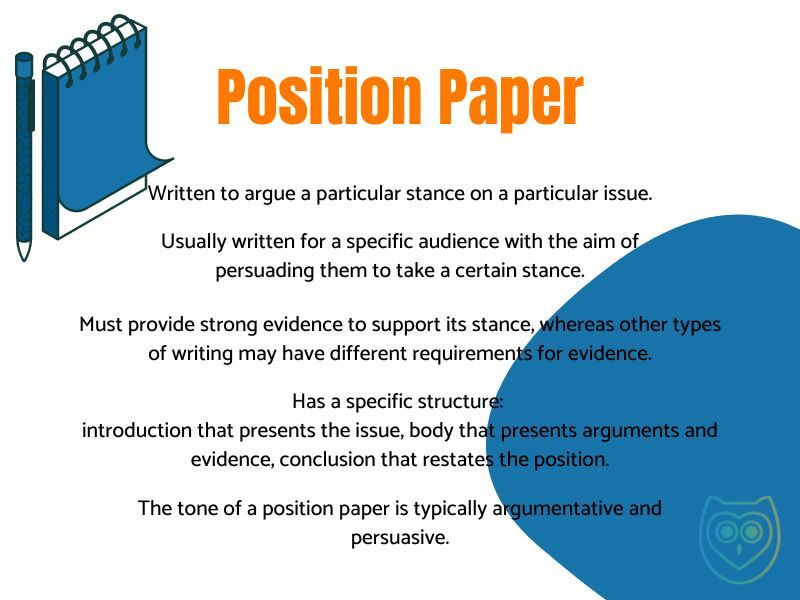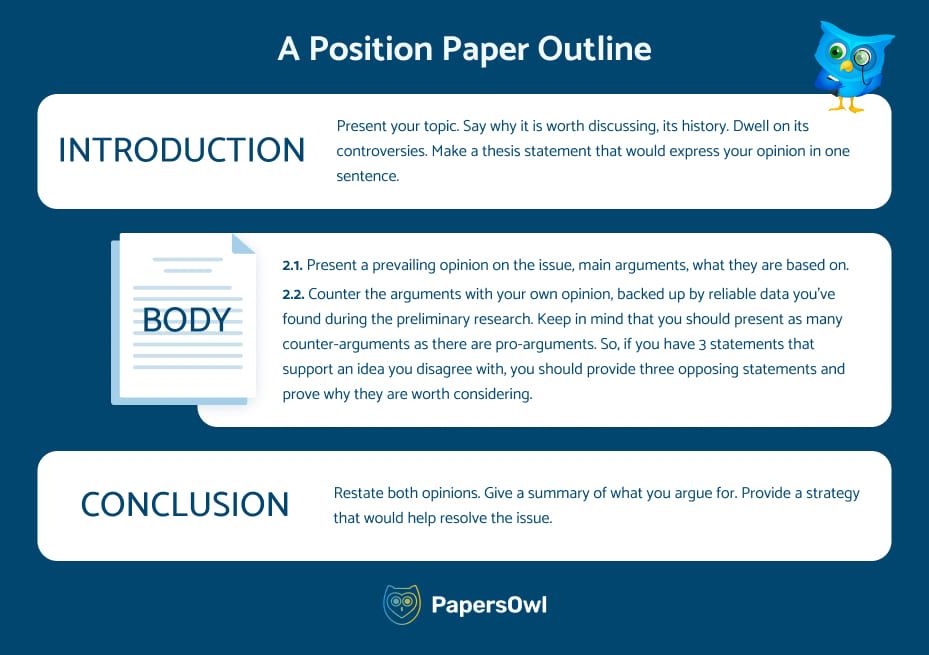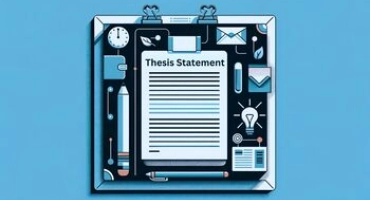A Guide to Writing a Compelling Position Paper
Table of contents
- 1 What Is a Position Paper?
- 2 An Effective Position Paper Format to Follow
- 3 Writing a Position Paper in Five Clear Steps
- 4 Strong Position Paper Outline Example
- 5 10 Tips on How to Write a Position Paper
- 5.1 Understand Your Audience and Tailor Your Approach
- 5.2 Choose a Topic With Debatable Sides
- 5.3 Cite Your Sources Properly and Include a Bibliography
- 5.4 Articulate Your Central Thesis Clearly
- 5.5 Examine a Topic and Gather Supporting Evidence
- 5.6 Construct Supporting Claims for the Positioning Statement
- 5.7 Anticipate and Study the Opposing Views
- 5.8 Construct Supporting Claims for the Positioning Statement
- 5.9 Ensure a Coherent Organisation and Structure of Your Paper
- 5.10 Proofread and Refine Your Paper
- 6 Position Paper Example Topics
- 7 Position Paper Example
- 8 FAQ
When learning how to write a position paper, the first step is to conduct thorough preliminary research. This research sets the foundation for the paper. It helps the author to explore various aspects of the topic and understand different perspectives. Once enough information is gathered, the author can develop a clear position. This issue will serve as the core of the paper. The idea presented must be specific and well-supported. The author should provide relevant sources to back up the arguments. A well-written position paper is not just a summary of facts. This carefully structured research paper makes a strong case for the author’s stance.
A strong position paper should present the author’s position and address the opposing side. This shows a well-rounded understanding of the topic and the ability to challenge other viewpoints. The author strengthens their position by presenting counterarguments. He refutes them with well-researched evidence. Clear, persuasive language is important. Every word must help convince the reader of the argument’s validity. Writing a position paper involves more than stating facts. It requires crafting a compelling narrative supported by thorough research and logical reasoning.
What Is a Position Paper?
A strong position paper is a form of academic writing. It presents the author’s well-researched stance on a specific issue. This issue is reinforced by relevant evidence such as facts, statistics, and credible sources. By constructing a clear thesis statement, the writer communicates their position. For instance, in a university setting, a teaching assistant might draft a position paper on the ethical implications of students using AI writing tools in academic assignments. This position paper will carefully weigh the efficiency AI can offer students against the risks.
Position papers can represent individual viewpoints. Also, it can communicate the official stances of larger groups or institutions. For example, a university’s writing department might publish a position paper on AI writing tools. This document could offer proposed solutions for ethical use. It could support the department’s thesis with specific examples and research. Such a document serves as a useful resource for faculty and students. It provides clear guidance on the department’s policy regarding such tools.
Position papers are important in fields like law, healthcare, research, and organizational policy. They allow groups to present clear solutions or positions on controversial issues at conferences or in academic circles. Authors use solid academic writing and careful research to build a strong case for their viewpoints. These papers often contribute to broader discussions or policy developments.
A high-quality position paper is based on knowledge and research. It gives readers the writer’s stance and a clear understanding of the topic. Whether in government policy or academic research, these position papers use real-world examples to support the thesis statement. This makes the solutions credible and practical.

An Effective Position Paper Format to Follow
Suppose you are wondering how to write a position paper. A good position article begins with a well-crafted title. Once you have decided on the position paper title, start with the position paper outline. A typical position paper structure introduces your topic and stance on a topic. The body of the position paper then follows it. The body includes counterarguments and claims that reinforce your position. It is then followed by a conclusion that reinforces your claim.
There are different types of research papers. The notable difference in an opinion piece is that two opposing viewpoints are presented without any one opinion being endorsed. However, in a position article, you need to support opposing another idea.
Writing position papers differs from other formats, and you want to set up a strong position. Here are five key differences in the form you should note if you are wondering how to write a position paper.
The best write research paper services will use the following components:
- While writing a position paper, the main goal is to argue a specific view and convince the reader to adopt the same idea.
- The writer must take a clear stand and defend it with solid reasoning and evidence.
- The text should incorporate research and sources to back what you are arguing throughout the parts of the position paper.
- The tone of the content needs to be formal and persuasive. It should be different from other types of documents, such as descriptive and narrative.
- The structure is also different; a good system must be followed to establish a solid position.
Writing a Position Paper in Five Clear Steps
Step 1: Choose a Topic
The first step in writing a position paper is selecting a topic that you can develop into a strong argument. A well-chosen topic allows you to present a clear position that aligns with your knowledge and interests. It’s essential to choose a subject that resonates with you. The subject should have enough depth to support a thoughtful and persuasive discussion. When writing a position paper, ensure the topic is specific enough for a focused argument.
Once you’ve selected your topic, define the stance you want to take on the issue. This will become the foundation of your position paper. It will shape the argument and guide your research. A strong position paper is built on a clearly articulated author’s position. You can confidently support this position with evidence. A well-defined topic helps you write a position that is logical, coherent, and easy for your audience to understand and engage with.
Step 2: Conduct Research
Once you’ve selected your topic, it’s time to conduct thorough research to build a strong foundation for your argument. Position papers rely on credible sources and relevant information to support the author’s stance. Start with preliminary research to gather background information on your topic. Then, identify different viewpoints and key facts. This helps you better understand the issue’s complexities and makes it easier to form a clear, informed position.
In a position paper, every statement should be backed by well-sourced evidence. During your research, explore different angles of the topic. Include opposing viewpoints so you can address counterarguments later. The research will strengthen your argument and provide the material needed to support your points.
Step 3: Write a Thesis
When research is completed, write a strong thesis statement. The thesis is the central argument of your position paper. It summarises the point you intend to make about your chosen topic. A well-crafted thesis statement should be clear, concise, and debatable. It should provide readers with a snapshot of your position. This statement will guide the structure of your position paper. It ensures that every section builds upon and reinforces your main argument.
A thesis statement in a position paper outlines your viewpoint and hints at how you’ll support it. It should be specific and focused, giving readers a clear understanding of your position on the topic. Developing a strong thesis early on creates a roadmap for your position paper. It makes it easier to organize your thoughts and research in a logical, persuasive way.
Step 4: Challenge Your Thesis
Once you’ve written your thesis statement, it’s important to challenge it. A good position paper doesn’t just communicate one side of an argument. It also considers potential objections and counterarguments. By addressing opposing viewpoints, you demonstrate a well-rounded understanding of the topic. You show that your position holds up against scrutiny. This process helps you strengthen your thesis by identifying weaknesses and refining your argument.
Challenging your thesis means anticipating the arguments others might make against your stance. In your position paper, you need to communicate these opposing arguments fairly. You need to use research and logic to refute them. This boosts your credibility and strengthens your position. It shows that you can engage thoughtfully with other perspectives.
Step 5: Collect Supporting Evidence
The final step in writing a position paper is collecting the supporting evidence to support your thesis. Evidence is the backbone of any strong argument and position paper. It’s essential to present facts, statistics, and authoritative sources that reinforce your claims. The more comprehensive and relevant your evidence, the more persuasive your position will be.
As you collect supporting evidence, draw from various sources to give your position paper credibility. Use research studies, expert opinions, and case examples to build a compelling argument. This evidence will help you substantiate your claims and counter any opposing points. It ultimately persuades your audience that your position is valid and well-supported.
Strong Position Paper Outline Example
Every good position paper outline should start with writing a title for a research paper. Having done that, you can proceed with the outline. Notably, this kind of paper resembles an opinion essay. But in the latter, you had to reveal two opposing opinions without necessarily sharing one of them. In the position paper, you need to counter an idea with that one of your own. So, a simple position paper outline example would look as follows:
Introduction
In the introduction, hook your reader with an engaging opening speech, then introduce your thesis statement. Then, briefly include your supporting argument.
- Define the issue and why it’s worth discussing;
- Introduce your topic;
- Discuss the background and controversies;
- Choose a position;
- Present your thesis statement and opinion in one sentence.
Body paragraphs
The body paragraphs are where you support your thesis statement. You can include as many paragraphs as you need, but remember that a position paper is typically a short piece of writing. Include one body paragraph per argument—including counterarguments. In each counterargument paragraph, demonstrate the flaws in the counterargument using relevant, credible facts and figures.
Be careful to balance paragraphs supporting your position and paragraphs discrediting counterarguments. Overall, your position paper should do more supporting than discrediting. The focus is your position’s strength, not its opposition’s weakness.
- Communicate the counterclaims and the evidence supporting them.
- State your position and refute the opposing claims. Ensure you reinforce your argument with data and statistics to establish a well-rooted claim.
- Ensure that the counter-arguments are equal to the pro-arguments. For example, give four statements that back your viewpoint for four counter-arguments.
Conclusion
In the final section, restate your position and summarize your argument. You don’t need to restate your thesis statement word for word. You should reinforce it here by summarizing your points in your position paper’s body paragraphs.
- Restate both viewpoints and summarise the side you are arguing for.
- Provide a plan of action with a suggested resolution.

10 Tips on How to Write a Position Paper
If you want to write an effective and well-crafted position paper, ensure your writing is clear and persuasive. Support it with robust research and evidence. Here are some tips for creating a position paper that effectively conveys your viewpoint.
Understand Your Audience and Tailor Your Approach
Before you start writing, it is crucial to know who your target audience is. Understanding your readers will help you decide the tone, language, and type of evidence to include in your position paper. For instance, if your paper is intended for industry experts, you can use technical terms and industry-specific data. However, if you intend to use it for students, keep the language simpler and use more accessible sources. By identifying your audience, you can adapt your style and ensure your position paper is engaging and persuasive to them.
Choose a Topic With Debatable Sides
Select a topic with clear opposing viewpoints to write an effective position paper. A strong position paper thrives on disagreement, which allows you to communicate a compelling argument. Choosing a widely accepted topic, like “the need for water,” won’t be as effective since it’s not debatable. Instead, choose a subject where credible research supports both sides of the issue, allowing you to craft an argument that stands out. Selecting a controversial or nuanced topic will make your position more persuasive and relevant.
Cite Your Sources Properly and Include a Bibliography
As you support your arguments with evidence, it’s not enough to simply mention your sources. Properly citing them is essential to lending credibility to your position paper. Include a bibliography or reference list if your paper follows APA, MLA, or another citation style. This adds weight to your argument and shows that your position is grounded in reputable research. Even when it’s not a formal requirement, citing sources demonstrates academic integrity and enhances the reliability of your position paper.
Articulate Your Central Thesis Clearly
When articulating your position and the central statement, ensure it is clear and precise. The thesis should be stated concisely and in the introduction of the position paper. This is to ensure it is clear what side you are taking on the issue under discussion. It serves as the foundation for the complete paper. Once you effectively position yourself while writing the introduction, the rest can focus on the supporting facts.
Examine a Topic and Gather Supporting Evidence
The first step in building a cohesive argument is to examine the topic and gather evidence. Start by carefully analyzing the issue and understanding the counter-arguments. In this way, you can formulate a well-informed position. The second step is to collect and review all evidence and facts. These should be extracted from reputable sources such as case studies, research papers, expert opinions, and statistics.
All the data that you gather needs to be relevant. With a solid foundation of your evidence, you can make a foolproof position statement and build superior quality paper.
Construct Supporting Claims for the Positioning Statement
To enhance your claim, it is crucial to build logical proofs. Introduce evidence to make your claims credible. When you write an essay stating your position, communicate each argument clearly and link it to your stance. Construct evidence to back your claim, and make sure you are also considering the opposing points.

Anticipate and Study the Opposing Views
To ensure your paper is sturdy, anticipate and study the opposing points. By considering all opposing views, you are more prepared for the objections to your supporting claims and can address them in the paper. This displays your commitment to your claim.
It also proves that you have considered all the alternative perspectives before deciding. It also strengthens your paper by showing that it is well-researched. So, whenever you start, research both sides. Then, list all the counterarguments made by those who disagree with your position.
Construct Supporting Claims for the Positioning Statement
Your writing style can make or break the paper. With a clear and straightforward manner, you can make your research the highlight. This will help you avoid anything that may need to be clarified for the reader. Even if you pay to have paper written, avoid complex language and use shorter sentences with simple vocabulary.
Also, remove any unnecessary words and irrelevant details. Stay focused on the main point to make your position unchallengeable. This will help the reader follow your line of reasoning without any distractions.
Ensure a Coherent Organisation and Structure of Your Paper
If you want to communicate your argument while also persuading the audience effectively, it’s important to focus on the structure of your writing. A well-structured paper helps communicate your idea clearly and cohesively. Usually, essay writers start by outlining the main points you want to cover in the article.
From the beginning to the end, ensure that the content flows seamlessly from one point to the next. The transition between sections also needs to be smooth. Also, use headings and subheadings to divide the text into paragraphs. These sections are then easy to navigate and comprehend.
Proofread and Refine Your Paper
Before submitting or publishing your position paper, do a grammar check and proofread it for any punctuation or spelling mistakes. Even the most well-researched paper can lose credibility if riddled with errors. Take the time to review your work or have someone else proofread it to catch mistakes you might have missed. Clean, error-free writing ensures your paper appears professional and that readers take your argument seriously.
Position Paper Example Topics
If you are wondering how to write a position paper, here are some example topics and titles you can take inspiration from:
- The Role of Artificial Intelligence in Revolutionizing Healthcare.
- The Gig Economy: Evaluating its Advantages and Disadvantages.
- The Future of Employment: How It Will Reshape Society.
- Social Media’s Impact on Mental Health: Causes and Consequences.
- Ethical Considerations Surrounding Genetically Modified Crops.
- The Role of Technology in Shaping Modern Education.
- Climate Change’s Effect on Wildlife and Biodiversity.
- Urbanization: Opportunities and Challenges in the Modern Era.
- Government’s Responsibility in Safeguarding Privacy Rights.
- Automation and AI: What They Mean for the Workforce of Tomorrow.
- Cruelty-Free Products: A Genuine Solution or Just a Marketing Gimmick?
- The Link Between Growing Income Inequality and Crime Rates.
- Virtual Reality: A New Frontier for Overcoming Physical Barriers.
- The Dual Use of Drones: Military and Civilian Perspectives.
- Remote Work: Is It the Future of Employment?
- Committee’s Role in Addressing Climate Change Policies Worldwide.
- A Historical Perspective on the Gig Economy and Labor Shifts.
- How Artificial Intelligence is Transforming Healthcare in Different Countries.
- The Committee’s Approach to Privacy Protection in the Digital Age.
- Exploring the Role of the United Nations in Promoting AI for Healthcare.
- Government Strategies in Managing Automation and its Effect on Employment.
- The Evolution of Work-from-Home Policies Across Different Countries.
- Drones: A Historical Look at Their Use in Military and Civilian Sectors.
- The Rise of Technology in New Roman Education Systems Across Countries.
- The History and Impact of Social Media on Mental Health: A Global Perspective.
Writing a position paper requires a lot of research and analysis of the current literature on the given topic. It’s necessary to understand the opinions of different stakeholders and consider all the facts before making a decision. To simplify the task, you can find services like PapersOwl who can write papers for you. With their help, you can get quality assistance with research, writing, and editing your position paper. They will provide the necessary support and guidance to make your position paper stand out. The first paragraph can’t be about how writing is a challenging task. Do not write obvious sentences and act like a pro writer in this paper type.
- Free unlimited checks
- All common file formats
- Accurate results
- Intuitive interface

Position Paper Example
“The Role of International Conferences in Addressing Climate Change”
As a delegate representing my country’s name at a global climate conference, I firmly believe international conferences are crucial in tackling climate change. Individual countries have made some progress. Coordinated action at the international level is essential to achieving real and lasting solutions.For example, my country has implemented several initiatives to reduce carbon emissions. However, the impact would be far greater if other countries followed suit. A key point raised during the conference was that climate change knows no borders. Therefore, a committee of nations must work together to address it. This committee can guide individual countries in adopting solutions that align with the broader global objectives.
Each nation must communicate its position clearly and ensure it is correct for national interests and global well-being. Countries can work collaboratively to create effective and sustainable climate policies by aligning these points.
One important point discussed at the conference was the need for governments to introduce more aggressive policies to combat climate change. This includes reducing reliance on fossil fuels and promoting renewable energy. However, without a united stance from other countries, efforts by a single country may leave loose ends, as climate change is a global issue. Past actions, such as the Paris Agreement, have shown the potential for coordinated efforts. However, much remains to be done to ensure these agreements turn into concrete actions.
In addition, the government must be prepared to show its country’s position clearly. During the conference, it was evident that countries with a well-defined stance made a stronger first impression. It is crucial when seeking support from other nations. A country’s position should reflect its national interests while aligning with global goals. For example, my country sees the importance of reducing emissions for both environmental reasons and economic growth through green technology. As the best delegate, it is essential to communicate the correct one, focusing on the key points that resonate with other nations. A clear and compelling position will help secure alliances and ensure meaningful contributions to the global effort.
Ultimately, issues like climate change require action. Governments and committees can work toward specific solutions that benefit all by engaging in these conferences. Countries must present a clear and unified position to avoid loose ends and contribute meaningfully to the global effort.







